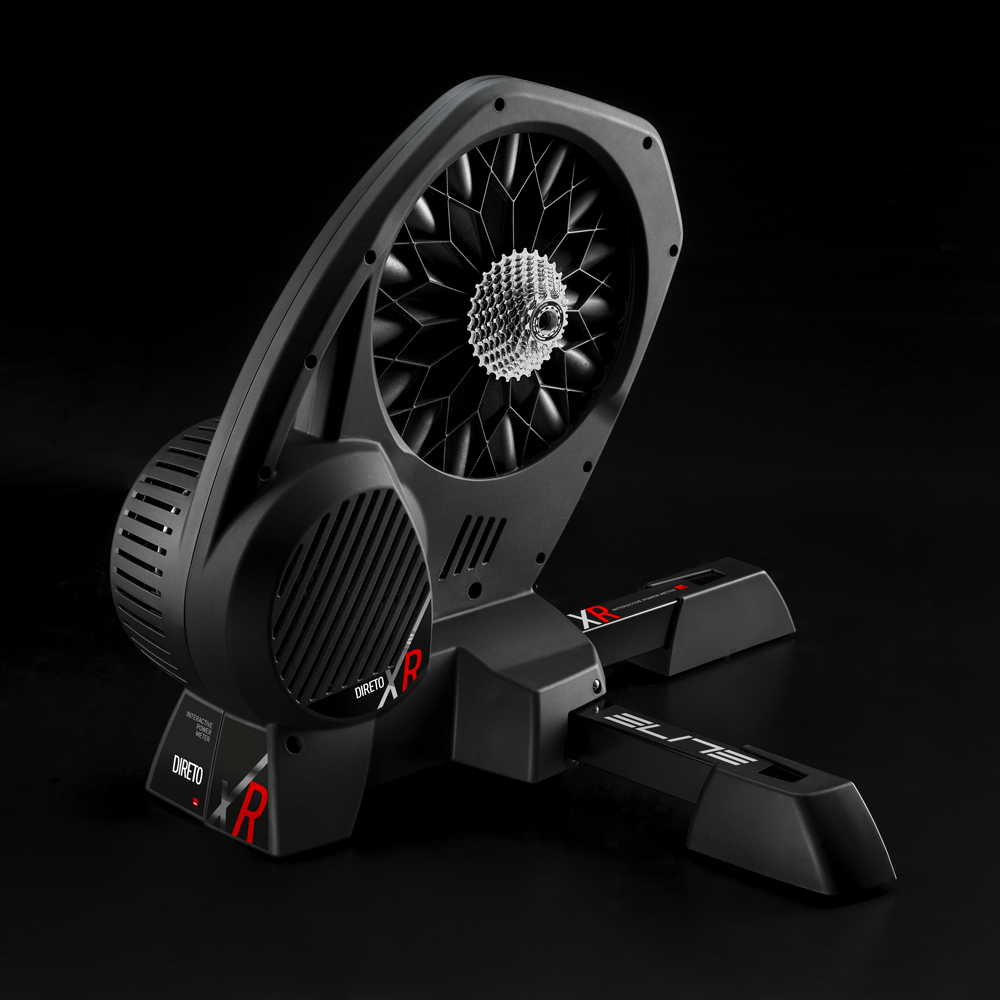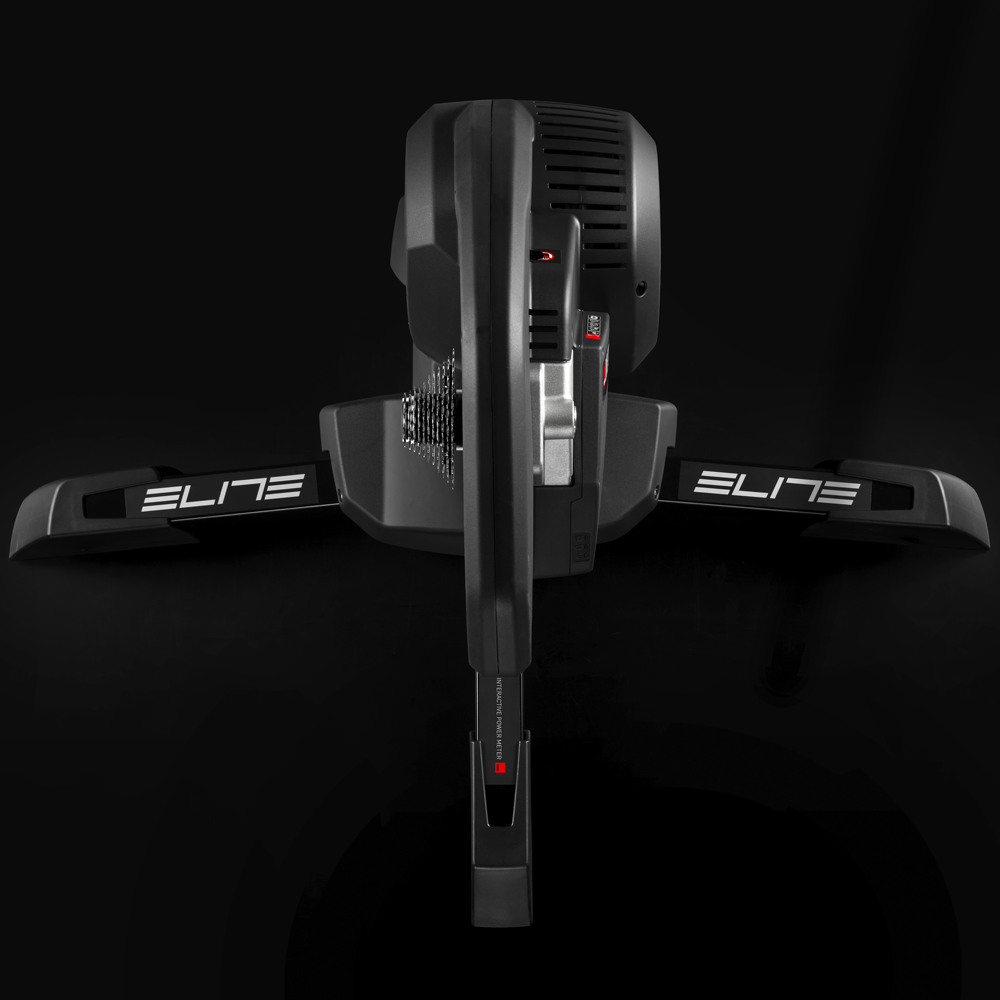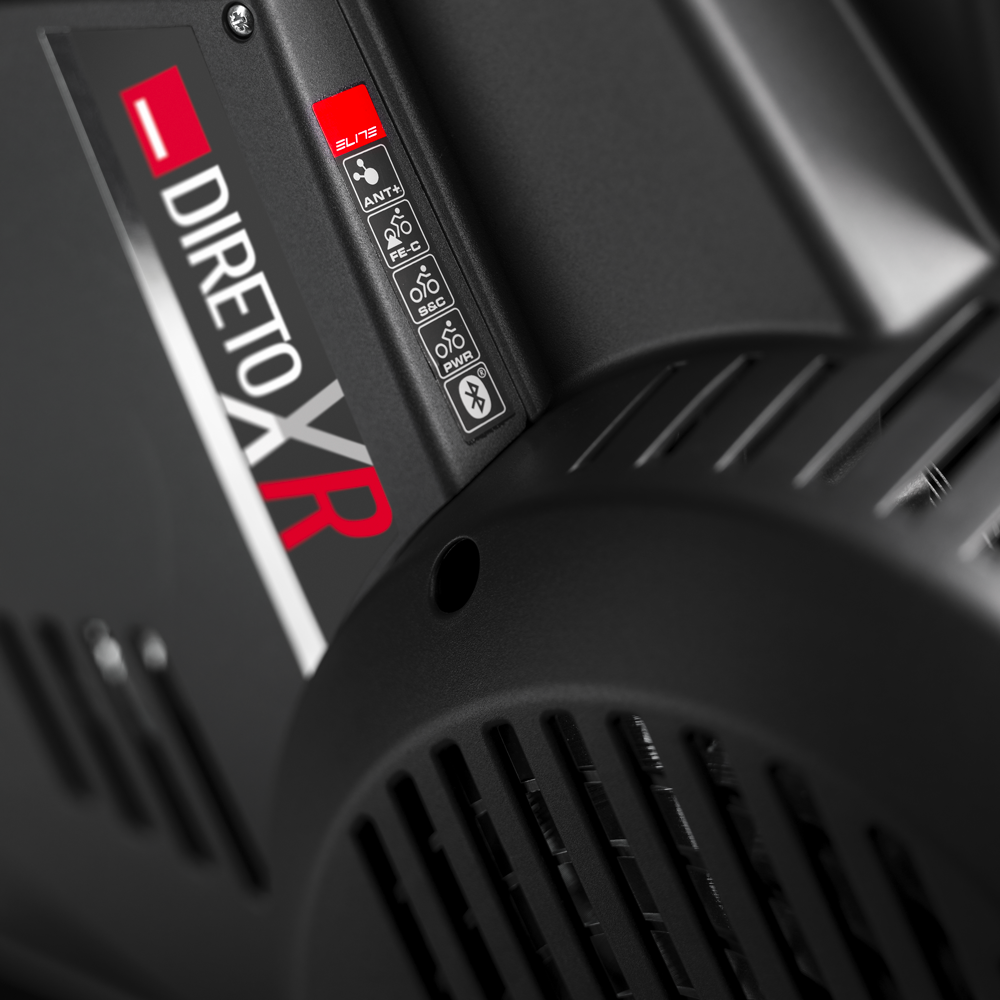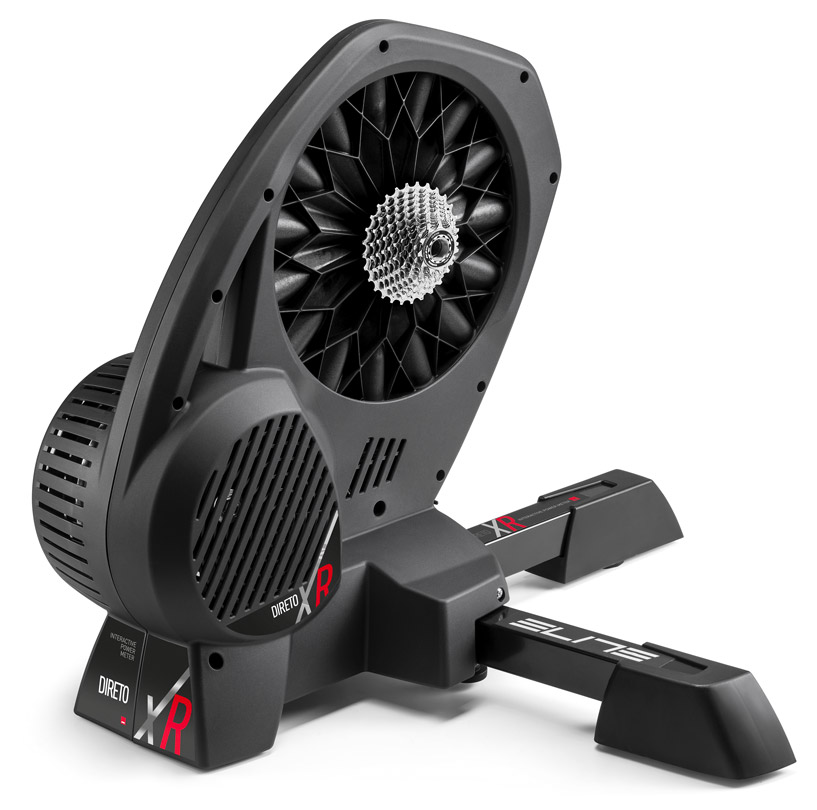Elite’s premium flagship home trainers are the Direto XR and the Direto XR-T. They are exactly the same trainer, but the XR comes with a Shimano 11-speed cassette (or equivalent) installed, while the XR-T does not. Of course, the Direto XR and XR-T are compatible with the RIZER, Elite’s gradient simulator with built-in steering, which I recently reviewed.
Note: throughout this review I will refer to the XR-T and XR, but keep in mind that everything written below also applies to both models, since the trainers are identical apart from shipping with or without a cassette.
Overview
The Direto XR-T is compatible with most bike frames, particularly those with a 130-135 x 5mm quick release or 142 x 12mm thru-axle. Both models accommodate long cage derailleurs and are compatible with 9/10/11 speed Shimano®/SRAM, 9/10/11/12 speed Campagnolo (and can be purchased separately), 12 speed SRAM NX, and 12-speed Shimano® Micro Spline cassettes.
The trainer has foldable legs, and with a weight of only 16kg it is quite moveable and easy to store. The feet are scratch-proof and adjustable, enabling you to ensure the trainer is level.
The XR-T communicates wirelessly via ANT+ and Bluetooth, as all modern smart trainers do. And the unit is accurate within ± 1,5% as a result of an integrated Optical Torque Sensor (OTS) power meter.
Compared to the previous model (the Direto X), the XR-T has an improved flywheel, simulates higher gradients (up to 24%), and can handle sprints up to 2400 watts.
Origins of the Direto
The story of the Direto starts in 2017 when Elite decided to introduce a trainer which had great features but was priced at a more affordable level. At the time, their top trainer was the Drivo.
The Drivo was accurate, stable, and nearly flawless. But its outer casing was made from white plastic and the trainer lacked the appealing look and feel of their competitors. Faced with competition from the Tacx Neo and Wahoo KICKR, Elite went back to their design studio. And thus the Direto was borne.
The first version simulated slopes of 14% Not the highest on the market, but it was as accurate as the competition within that price point. For this reason, it soon surpassed Elite’s own Drivo as the “go-to” trainer offered by Elite.
Seeing the consumer’s desire for the product in market sales, Elite decided to update the Direto family. The Direto evolved into the Direto X in 2019, which simulated gradients up to 18% with improved power accuracy.
As a consequence of the Direto’s success, the Drivo II was discontinued and Elite focussed their attention on developing the Direto X with the objective of delivering high-end technology at more affordable price. Thus came the Direto XR, announced in July 2020.
(Interestingly, the R in the name, stands for RIZER, which the unit is compatible with. The RIZER was originally planned to be launched in conjunction with the new Direto XR, but timescales were impacted by the onset of the global pandemic and Elite, like all businesses, had to adjust their timescales accordingly.)
Product Testing and Release
Before releasing the product, the Direto XR model underwent three levels of testing.
- Elite employees
- Testers
- Pro cyclists
The first level of testing involved the Project Team. They checked whether the trainer met Elite’s specific requirements.
The second level involved Testers. There are in excess of 15 Testers at Elite. All are cyclists who understand the technicalities of indoor cycling, and they provided feedback to the Project Team. The Testers undertook rigorous testing, including seeing how the product worked in ERG mode and in all situations you can imagine.
The third level is testing by the pro cyclists.
After thorough testing, the product is approved and moves to mass production. From concept to production 2 years passed.
Setting Up
The trainers come ready assembled and all you need to do is fold out the legs and secure them into position. Of course, depending on what model you acquired and what bike you are using, you may or may not have to install a cassette. (You will need to buy a separate freehub for Campagnolo, SRAM 12 speed, and Shimano Micro Spline cassettes, although this is the same for all turbo trainers on the market today.)
The trainer weighs 16kg – lighter than its competitors and easier to position into place. When I compare the design to its competitors, it would appear that this weight saving has been obtained by using a different style of plastic for the outer casing, which perhaps is not as aesthetically pleasing.
Once you have positioned the trainer into place and installed the cassette, install the relevant axle adapter to fit your bike, by simply slotting them into place. Plug in the trainer and away you go. Included is a block to raise your front wheel. You may want to consider configuring it using the My E-Training app, which can be downloaded to your smartphone.
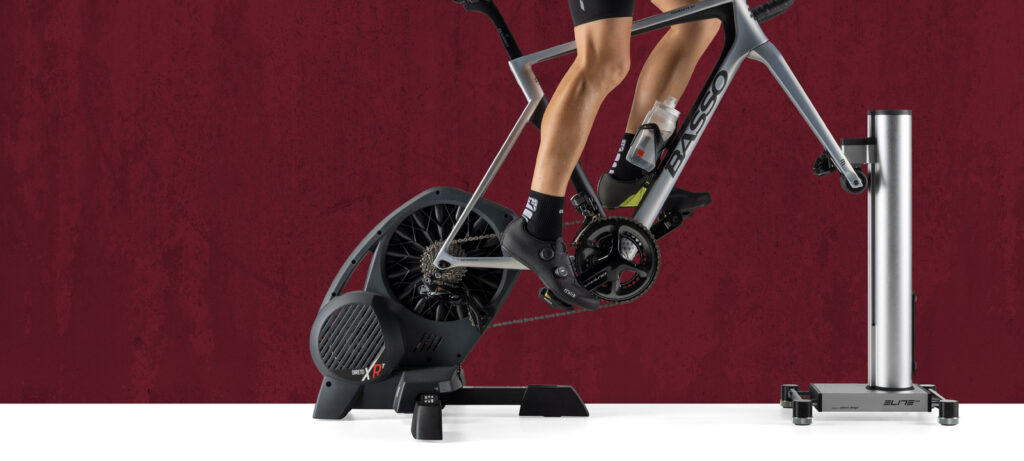
Technical Specs and Pricing
The technical details of the product are as follows:
- Power Meter: Integrated OTS (Optical Torque Sensor)
- Power Meter Accuracy: ± 1,5%
- Wireless Communication: ANT+ (FE-C, Power, Speed & Cadence) and Bluetooth (FTMS, Power and Speed Cadence)
- Max Slope Simulated: 24%
- Max Power: 1100 Watt (20km/h) – 2400 Watt (40km/h)
- Flywheel Weight: 5.1kg
- Bike Compatibility: Road bikes, Mountain bikes, City bikes – including carbon ones, with 130-135 x 5mm hubs and with quick clamping system and 142x12mm with thru-axle (an adapter for 135×10-12mm and rear 148x12mm Boost hubs is available)
- Cassette Compatibility: 9/10/11 speed Shimano/SRAM, 9/10/11/12 speed Campagnolo, 12 speed SRAM NX, 12 speed micro Spline Shimano. Separate freehub required for Campagnolo, SRAM 12, Shimano Microspline
- Dimensions Open (Length x Width x Height): 650 x 840 x 550 mm / 25.6’’ x 34’’ x 21.6’’
- Dimensions Closed (Length x Width x Height): 650 x 300 x 550 mm / 25.6’’ x 11.8’’ x 21.6’’
- Weight: 16 kg / 35.30 lb
Cost:
- Direto XR €864.99/£829.99/US$999.99
- Direto XR-T €824.99/£799.99/US$949.99
Key Feature: Integrated OTS (Optical Torque Sensor)
The Direto XR and XR-T feature the OTS which Elite explains is “a power meter based on an optical sensor technology that measures the torsion of the trainer axis and on sophisticated electronics processing. This power meter is able to read the power output with exceptional precision.”
This integrated power meter measures how much power you put into the pedals with ± 1,5% accuracy, which is 0,5% more accurate than the first Direto. Elite state that the Direto XR-T “is one of the most accurate commercially available home trainers.”
Technical Support
When you purchase a trainer from Elite, you are not just purchasing the trainer, but the support that comes with it. I will explain in greater detail.
When my Direto XR-T arrived and I connected it to Zwift, I noticed some irregularities with the movement of the avatar. It was like it was moving in slow motion. I immediately contacted Elite about the issue and within a day, a solution was provided. It was related to software and I needed to reconfigure the trainer. This solved the issue, however, upon using the trainer in ERG mode, there were issues with the level of resistance applied by the trainer.
Another email was sent to Elite, along with the relevant FIT file for the ride in question and within the day (5pm), I was having a video conference call where I was walking through the issue with the technician, including providing detailed information about the model. The following morning, I had been informed that a replacement trainer had been dispatched and I was to make arrangements to return the faulty one.
This was reliable customer service. Furthermore, there was no mention that I was from Zwift Insider, so did not receive any preferential treatment.
Elite was apologetic about the situation, but to me, it was not an issue because this is complex technology and all technology has issues at some point (including my old trainer, which was from a competitor – my challenges with that can be read in my VEveresting challenge post). To me, the important point is how the issues are dealt with. In this case, I was impressed with Elite’s efficiency and resolution. I am highlighting this because I think support for your product is important and I want to know that if I have an issue, there will be someone to engage with and resolve the matter.
Elite also responded to inform me that after investigating the issue, it was related to the motherboard and a small bit of soldiering on one of the contacts caused the issue – this reinforces my point about these being complex pieces of technology that can have issues.
Ride Experience
How Does It Feel?
Due to the size of the flywheel, the trainer can feel a little hard to get moving, but once it is spinning, it has a nice feel. This is true of all flywheel-based trainers. Before any event begins, it is particularly important to have your legs spinning so you are not left behind at the start!
Responsiveness and Accuracy
Once you are moving, the trainer is responsive and you can increase the power by going through the gears. I did a couple of tests to the accuracy of the trainer, one which could be considered “old school” and another a bit more scientific.
The “old school” test consisted of me tackling the Volcano climb on the Direto XR-T and comparing my time to what I did it previously on my other trainer, the Tacx Flux S. Back in the day, when comparing bikes we didn’t have the technology to compare power and times in the finest detail. We just rode hard and saw if there was a big time gap between the bikes! So this test was a throwback to those days where we were not so consumed by data.
I topped out in 7:01 on my Tacx Flux S, and with the XR-T, I completed it in 6:57. So both within a few seconds of each other.
Fortunately, I have some power pedals (Garmin Vector 2S) so I can compare the power in fine detail in a more scientific way. Here is the data from my pedals compared to the trainer power in a second max effort climb of the Volcano (see the live data on ZwiftPower):
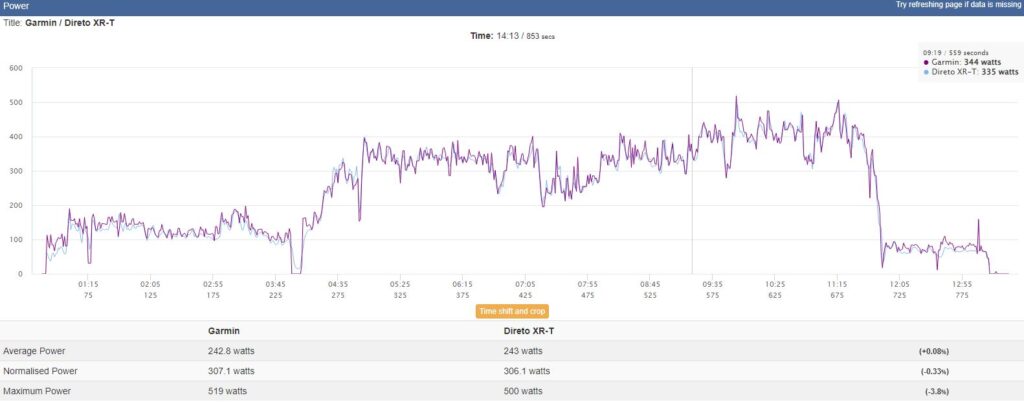
The key points to highlight are my normalised power when climbing. The difference between the Garmin Vector 2S pedals and the trainer was -0.33% in favour of the pedals, but the average power was only +0.08% different. Just as an FYI and harkening back to my “old school” test, I completed the Volcano Climb in 7:12 this time, but as you can see, I only really increased the power towards the end and kept it largely steady.
In terms of sprinting, I have undertaken 3 sprints and dual-recorded the data. The trainer was more favourable, by +2.08% than the Garmin Vector 2S pedals. Data can be seen in the diagram (and live here on ZwiftPower), including where I had a rest after my first “all-out effort.” Yes, I’m not a sprinter and I didn’t top 800 watts but I tried to push it for the purpose of highlighting what the trainer can do. The trainer does respond as you can see from the diagram and the limiting factor in the test was my ability. Furthermore, you can see how quickly the trainer responded to the increase in power.
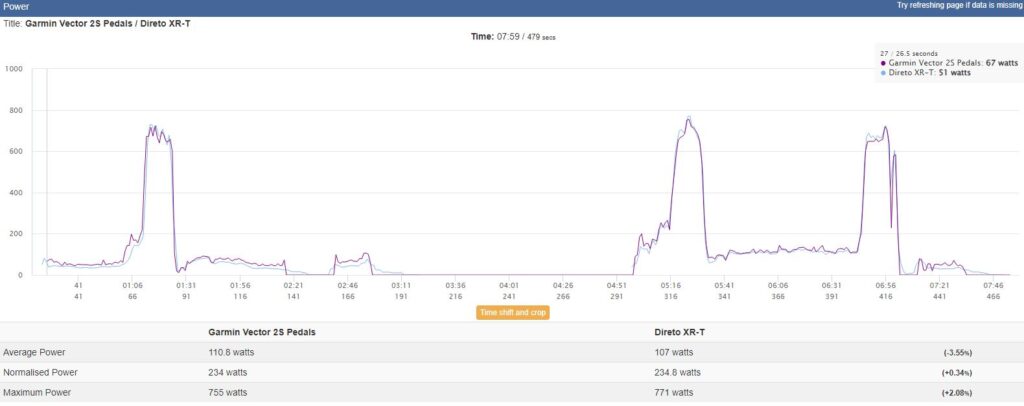
In terms of power accuracy, my Direto XR-T performed well within spec.
Talking of accuracy and power, compared to my Tacx Flux S I really noticed the difference with the OTS as there are more micro fluctuations on my power graphic at the bottom of the screen. It’s really nothing to worry about as i already noted, the accuracy is there. This includes changes to the gradient of Zwift, the trainer responds immediately to the onscreen gradient, including when the RIZER is attached.
Noise
It’s whilst sprinting the trainer makes the most noise, reaching 80 decibels (dB), but normally it ranges between 60 and 70 (dB) which translates to “noise levels in an office environment.”
To put it simpler, I was able to listen to podcasts and have a conversation and you certainly will not wake anyone if you are doing an early morning Zwift session. It sounds comparable to my Tacx Flux S trainer.
ERG mode
It works. And works well. This mode was used extensively and was what I used to highlight to Elite the issues with the power of the first trainer. My second trainer works as expected in terms of applying the right level of resistance. I think the correct phrase to use when describing the ERG mode is that “it keeps you honest.”
Summing Up
Elite’s Direto XR-T is a quality trainer with good functionality. The replacement trainer I received works without issues. It’s reassuring to know that if there are subsequent problems, support is on hand to resolve them quickly.
The XR-T performs well, including how the resistance feels whilst climbing and when combined with the RIZER, offers a complete experience.
Italy is famed for beautifully-designed buildings and machinery which marry form and function – the Coliseum and Ferrari being examples. It would be nice to see the next version have that Italian design flare applied, since so many people leave their bike permanently connected to their trainer.
Smart Trainer Index Summary
Here are the Directo XR trainer details from Zwift Insider’s Smart Trainer Index.
Overall Rating
(11 reviews)
